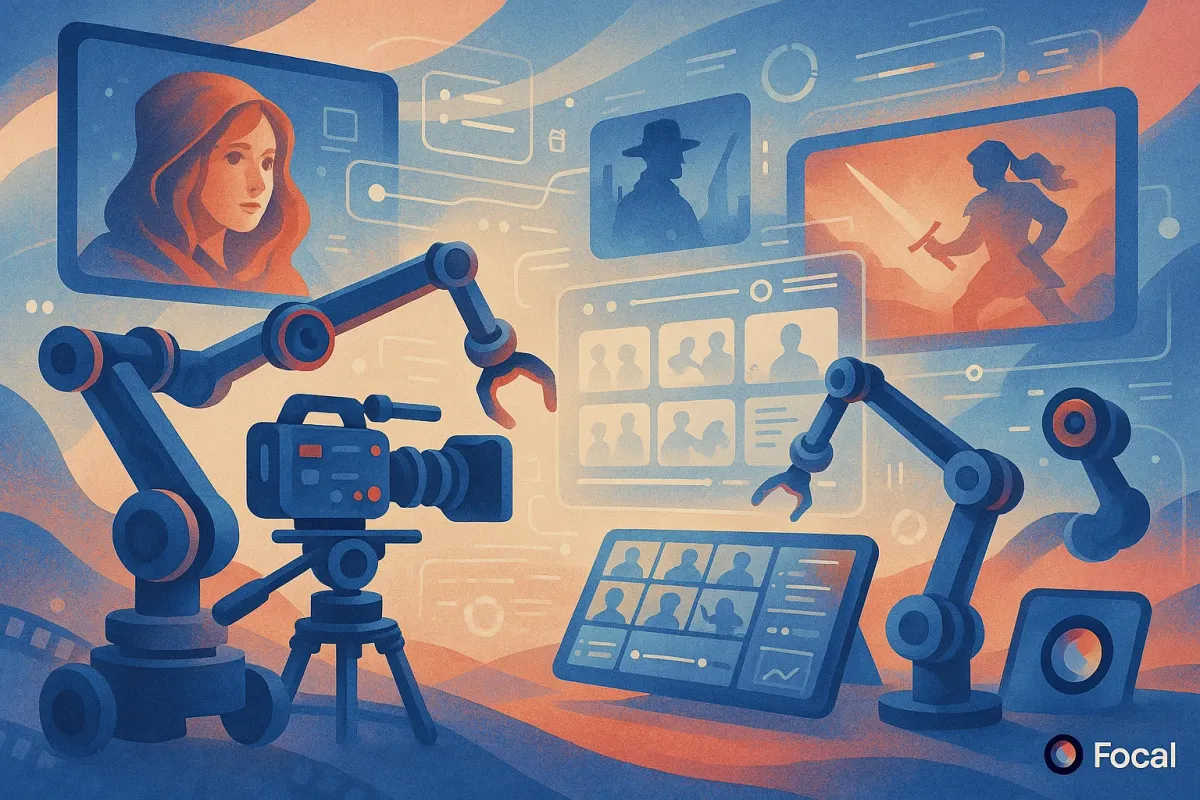The Future of AI in Filmmaking: Key Trends to Watch in 2025

AI in filmmaking isn’t some theoretical “someday” concept anymore—it’s already here, and it’s weirdly good.
From generating full scenes to animating scripts with voice, movement, and mood, AI tools are reshaping how stories get made—and who gets to make them. This year, we’re seeing more creators use AI not to replace the creative process, but to accelerate it. Ideas that used to live in journals and Google Docs are now showing up as full-on films.
At Focal, we’ve been building right in the middle of it all—and honestly? 2025 is looking cinematic in the wildest way: getting direct access to the kinds of AI tools that used to be locked behind R&D labs and demo reels. Now, they can be a part of your workflow.
1. AI-Driven Pre-Production and Visualization
Storyboarding, moodboarding, casting ideas, and location scouting — all of it is getting faster and more affordable thanks to generative AI. In 2025, filmmakers won’t just imagine their vision in pre-production — they’ll prompt it. Scene layout, camera angles, tone, and even lighting styles can be previewed instantly, replacing static storyboards with dynamic, style-matched visuals.
The Rise of Visual Generation Models
AI models like Runway, Midjourney, and others will become core tools for directors and DPs. Filmmakers will prompt entire scenes — “sunset-lit rooftop fight in rainy Tokyo” — and see fully realized frames within seconds. Pre-vis becomes more fluid, collaborative, and stylized.
Why This Changes Everything
Directors and creative teams can align before production starts, locking in aesthetics, compositions, and tone. Pitching becomes easier. Indie creators level up. And expensive concept art phases can shrink from weeks to hours — without compromising quality.
2. Adaptive Storytelling and Dynamic Scripts
AI in 2025 isn’t just auto-generating text — it’s co-writing screenplays with plot logic, emotional arcs, and character consistency. Writers will use AI models to shape branching narratives, generate alternate scenes, and build dynamic script templates that adjust in real time.
Language Models Turn into Writing Rooms
Instead of staring at a blank page, writers will input prompts like “act 2 midpoint with emotional betrayal” or “alternate ending where the antagonist wins.” The model responds with structured, genre-aware scenes that follow storytelling logic — not just pretty text.
The Power of Modular Narratives
Want to test three versions of the same episode? Create dark, hopeful, or satirical rewrites with a single click? In 2025, AI gives filmmakers the ability to remix their vision without starting from scratch — making faster pitches, better feedback loops, and smarter edits.
3. Multi-Model AI Pipelines Take Over Post-Production
AI is set to revolutionize post-production with modular, task-specific models that work like plugins in a creative workflow. In 2025, filmmakers will automate pieces of the pipeline — from voiceovers to motion smoothing — using multiple models tuned for different jobs.
The Breakdown of the Post Stack
You’ll use one model for voice synthesis, another for rotoscoping, another for AI-enhanced VFX, and yet another for stylized color grading. This multi-model approach means more control, more experimentation, and way less manual labor.
From Timeline Hell to Real-Time Editing
Instead of endlessly tweaking timelines, creators will prompt changes: “make this shot feel dreamlike,” “swap in analog-style voice,” or “add cinematic tension with music pacing.” What once took hours of rendering becomes near-instant creative flow.
4. Indie Creators Will Push the AI Frontier
AI filmmaking isn’t going to be pioneered by big studios — it’s already exploding among indie creators and solo storytellers. 2025 will be the year we see viral short films, weird internet series, and experimental trailers go global — all created using AI tools from a laptop and a bold prompt.
The Rise of Prompt-First Filmmaking
On YouTube, TikTok, and Discord, creators are using generative models to build lo-fi sci-fi, animated sketch series, vaporwave thrillers, and fake trailers that feel very real. They’re not waiting for greenlights — they’re shipping content daily, with AI as their production team.
A New Era of Visual Internet Culture
The next cult-classic project might be made entirely in-browser. AI opens doors for weird, genre-bending experiments that build loyal followings fast. The line between “indie short” and “studio trailer” is already blurring — and the audience doesn’t care how it was made, as long as it hits.
How Focal Fits Into the AI Filmmaking Future
While AI tools are multiplying by the day, Focal brings them together in one purpose-built platform for storytellers. It’s designed for creators who want to build full visual narratives — not just generate clips. Whether you’re exploring tone, building a pilot, or remixing a teaser, Focal gives you access to multiple AI models, prompt editors, and remix tools — all in one place.
Focal isn’t just about speed — it’s about storytelling at scale. You can write scenes, generate visuals, preview styles, and export complete packages in minutes. That makes it easier to pitch concepts, build out series, or just experiment without friction.
And as AI filmmaking continues to evolve, Focal is built to grow with it — adapting to new models, styles, and creator workflows. It’s your launchpad for whatever the next wave of cinema looks like.
Don’t Wait for the Future—Start Creating in It
AI isn’t just adding features to filmmaking—it’s changing the starting point. Tools like Focal let you storyboard, generate, edit, and voice full sequences without needing a studio setup or six different apps.
You don’t need permission to begin, and that’s what’s so powerful. The real trend to watch in 2025? More stories, from more storytellers, with fewer blockers in the way.
Test the Future of Filmmaking—Right Inside Focal
📧 Got questions? Email us at [email protected] or click the Support button in the top right corner of the app (you must be logged in). We actually respond.
